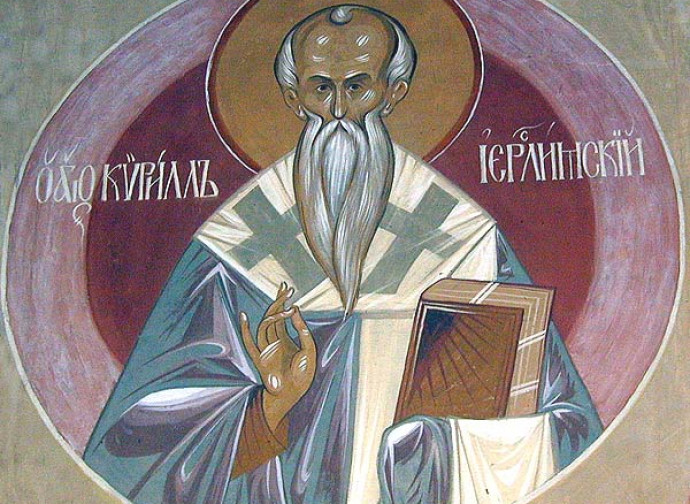Saint Cyril of Jerusalem
He took part in the theological dispute over the Arian heresy and left us inspiring pages on the preparation of catechumens for Baptism and the real presence of Christ in the Eucharist.

Proclaimed Doctor of the Church by Leo XIII, Saint Cyril of Jerusalem (c. 313-387) took part in the theological dispute over the Arian heresy and left us inspiring pages on the preparation of catechumens for Baptism and the real presence of Christ in the Eucharist. He received an excellent literary education, and was ordained priest by the bishop of Jerusalem, Saint Maximus. He found himself carrying out his ministry in a city that under the Emperor Constantine had regained its splendour, thanks to the rediscovery of the Holy Sepulchre (which was followed by Constantine’s erection of the basilica, consecrated in 335) and of the True Cross, found by Saint Helena with the precious help of Saint Macarius.
Around 350 Saint Cyril became bishop of Jerusalem, with the support of Acacius (†366), metropolitan of Caesarea and pro-Arian, who probably considered him an ally. For some time this fact led to doubts about Cyril's orthodoxy, but in reality very strong disagreements soon arose between him and Acacius, deriving both from questions of canonical precedence between the two episcopal seats and from the teachings of the saint. In his Christological doctrine, Cyril failed to use the term “consubstantial” present in the Nicene Creed and opposed by Arianism, but he fought the Arian formulas and clearly affirmed the divinity of the Son and his being coeternal to the Father. In 381, moreover, he participated in the Council of Constantinople and also subscribed to the doctrine on consubstantiality, now convinced of the absolute appropriateness of the term in relation to the identical substance of the three Persons of the Most Holy Trinity.
In the meantime, the Arian faction had condemned Cyril to exile three times: the first in 357, by order of a synod convened by Acacius (the accusation concerned the sale of goods of the diocese, the proceeds of which Cyril had used to help the poor in times of famine); the second in 360 at the behest of Emperor Constantius (again influenced by the metropolitan of Caesarea); and the third in 367, on the decision of Valens, another Arian emperor. The last exile was the longest and lasted 11 years, since Cyril could only return to Jerusalem after Valens' death.
In the Holy City, at the beginning of his episcopate, he had admired in the sky above Calvary “a giant cross of light extending to the holy Mount of Olives”, as he wrote in his Letter to Constantius in 351. Among Cyril’s writings we also have 24 famous sermons, collected under the title of Catecheses. The first 19 catecheses, including the Procatechesis (Prologue), are addressed to catechumens awaiting Baptism, to help them understand the importance of the sacrament they are about to receive, the reality of sin, the need for penance, and the gift of Faith. The last 5, called “mystagogical catecheses”, are addressed to the newly baptised to guide them in in-depth studies of the Paschal mysteries and of the grace received: “Just as the Saviour, after Baptism and the descent of the Holy Spirit, went out to fight against the adversary, so too, after holy Baptism and the mystical anointing, clothed with the entire armour of the Holy Spirit, resist the power of the adversary and fight it by saying: ‘I can do all things through Him who strengthens me’”.
To learn more:
Catechesis of Benedict XVI on Saint Cyril of Jerusalem (General Audience of June 27, 2007)




